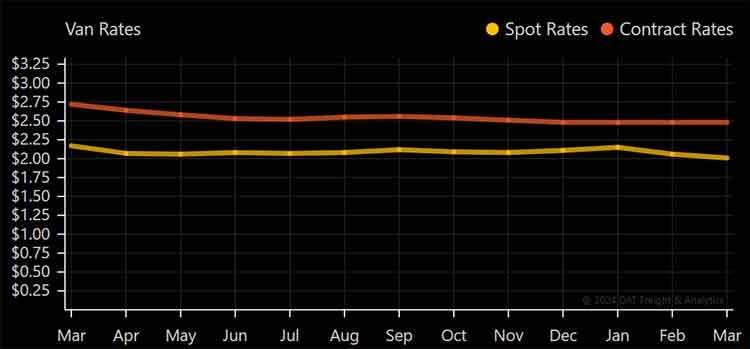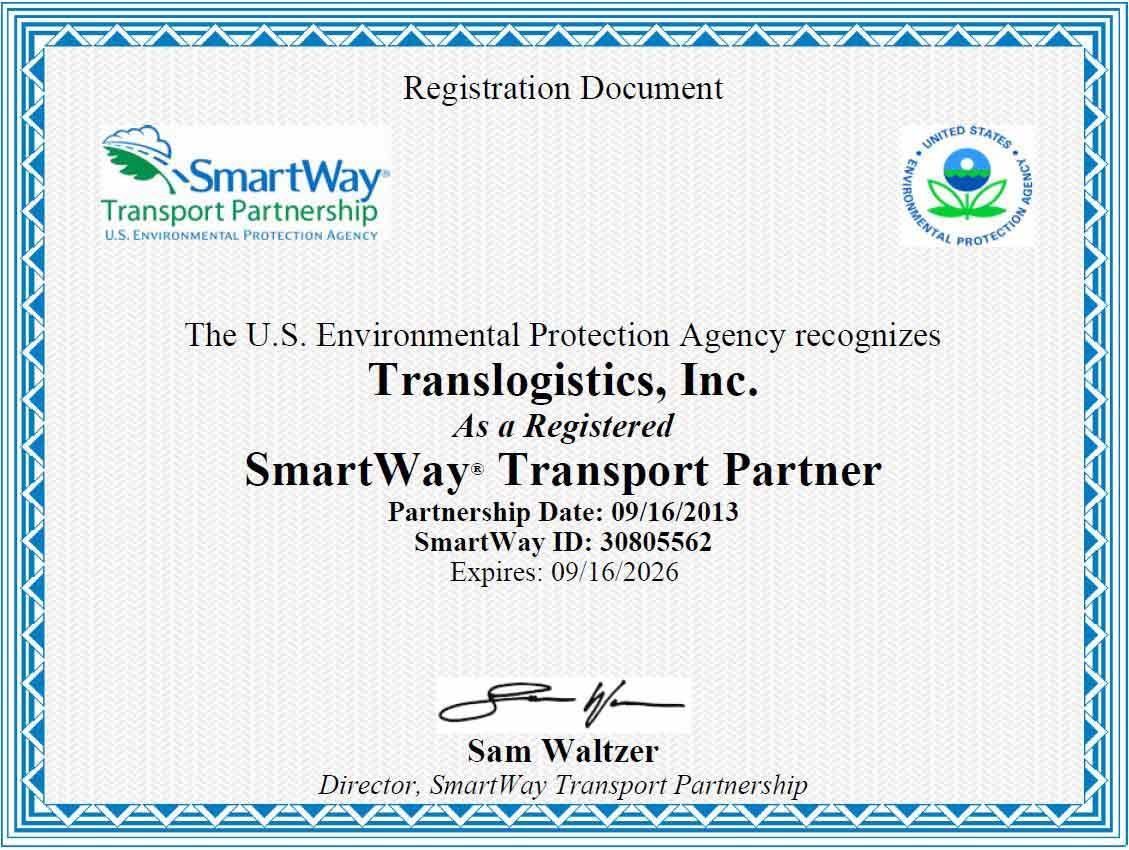Freight contract vs spot rates, what's the difference?
What is the difference between freight contract and spot rates?
Contract rates typically remain fixed for a duration of one year, while spot freight rates fluctuate based on current market conditions, often changing rapidly, sometimes even on an hourly basis.

Recently, spot freight rates have been lower than contract freight rates. However, both transportation modes' markets are highly unpredictable. The comparison presented above outlines the differences between contract and spot rates in detail. Spot freight rates are negotiated individually for each shipment, leading to periodic changes influenced by demand, supply fluctuations, fuel costs, and other factors. Contract rates offer more consistency, making them simpler for freight invoice audits, whereas spot rates may present increased risk of improper carrier billing.
Why do shippers and carriers use contract rates?
The FTL truckload market is extensive and characterized by significant fragmentation, comprising thousands of carriers and shippers, each with distinct agendas, strategies, and networks. This dynamic creates an environment where pricing and carrier capacity are constantly in flux, making predictability a challenge for both supply and demand sides of the market.
- Reasons shippers prefer contract rates include:
- Easier budgeting and forecasting
- Access to more reliable capacity
- Ability to forge strategic carrier relationships
- Enhanced provider accountability through KPI tracking
Carriers, on the other hand, favor contract rates for their ability to provide more predictable revenue, facilitate consistent and efficient driver scheduling, and increase driver satisfaction.
Contract Freight Rates vs Spot Freight Rates
In recent years, the freight market has seen remarkable instability due to various factors like seasonal shifts, supply chain alterations, and geopolitical and economic shifts, resulting in turbulence within the logistics industry. This volatility led to a surge in contract freight rates in 2022, followed by a crash in the spot market in 2023, while contract rates remained relatively higher with modest degradation. This has strained transportation budgets significantly, prompting shippers to seek more economical alternatives like spot freights. In 2024, spot market rates continue to decrease as ample carrier capacity remains available.
Traditionally, shipping companies have favored contract freight for stability and cost predictability, reserving spot freight for ad-hoc shipments. However, the current market conditions present a unique opportunity for spot freights. Unlike fixed-contract rates, the spot rate market allows shippers to capitalize on fluctuations, often resulting in lower shipping costs. Nonetheless, it's vital to carefully evaluate how each option aligns with your specific business needs before choosing the most cost-effective shipping method. In this article, we compare spot freight versus contract freight to help you determine the most suitable option for your business.

What is Spot Freight?
Spot freight entails paying for deliveries on a per-load basis, with rates subject to frequent fluctuations due to the highly volatile spot market, prompting carriers to determine shipment prices individually before each delivery. Shippers typically gather quotes from various services to assess cost, service quality, delivery time, and transit time before selecting a transportation provider. Spot freight offers businesses flexibility compared to contract freight, enabling them to fulfill last-minute or one-time shipping needs without being tied to long-term agreements, facilitating adaptation to sudden increases in demand and aiding in delay mitigation and volume restriction avoidance.
However, fluctuating market conditions may lead to price hikes, posing challenges for companies shipping large volumes, and the process of finding optimal spot rates can be laborious and resource-intensive. Shippers can address these challenges using a digital TMS software platform like ViewPoint, which utilizes an algorithm to provide shipping of spot freights and assists in compiling a list of contract carriers meeting pricing, capacity, and other requirements on shipping lanes where applicable.
Spot rates represent short-term, transactional pricing influenced by the current supply and demand dynamics in the truckload market. Shippers turn to spot rates for three primary reasons:
- When their primary and backup carriers are unable to cover a shipment.
- In cases of urgent and unexpected shipments.
- When there is insufficient freight density or consistency to warrant contract pricing.
Most shippers utilize a strategic mix of contract and spot rates for their freight needs.
| Contract Rates | Spot Rates |
|---|---|
| Long-term pricing | Short-term pricing |
| Stable | Dynamic |
| Cover a shipping lane | Cover a single shipment |
| Procurement Event (RFP) | One-time quote |
| Favorable for shippers | Favorable for carriers |
| Base Rate + FSC | All-in rate |
| Performance Tracked with KPIs | Less performance oversight |
What is Contract Freight?
Contract freight involves a structured shipping solution governed by predefined freight rate agreement, where shippers and carriers negotiate rates based on specific freight and shipment needs, typically for a predetermined duration and estimated volumes along a designated truckload freight shipping route.
Despite the prevalence of spot freight options, contract freight remains favored by many companies due to its rate predictability, which helps mitigate peak-season surcharges and enhances supply chain management efficiency, while also reducing shipping management resources and ensuring a consistent shipping experience.
However, committing to a long-term contract may pose disadvantages for
smaller shippers, as while fixed rates provide stability against spot market volatility, they may also preclude the possibility of securing prices below industry benchmarks. Additionally, for small and medium businesses with fluctuating shipping volumes, adhering to contracted shipment volumes can result in increased costs over time, potentially becoming burdensome. Let's now explore which option is better for you as a shipper!
What is the difference between spot and contract freight?
The key distinction between spot and contract freight lies in how payments are made. Spot freights involve one-time payments, whereas pricing for contract freight is agreed upon through negotiations between shippers and carriers.
When choosing between contract and spot rates, it's crucial to take shipping needs into account.
Factors such as the nature of the goods, distance, and route play a significant role. Additionally, considering the shipment's urgency, volume, and budget is essential. By thoroughly assessing these factors, you can make a well-informed decision about which option best suits your needs. A freight broker like TLI can greatly aid a shipper in determining the best method of transportation pertinent to the details of each shipment.
When should I select spot freight rates?
Spot freights, like contract freights, have their advantages in certain situations. Knowing when to use them can help meet unpredictable demand and optimize costs. Strategic use of spot freights is also crucial for securing guaranteed capacity on short notice.
Spot freight is most useful in these five scenarios:
- Irregular and low-volume shipments: Companies with sporadic or low shipping demand can benefit from spot freight, adjusting capacity as needed and saving resources on lower-than-typical shipment volumes.
- Limited advance notice: Spot freights allow for a much faster shipment process, making them ideal for shippers needing to send goods on short notice, with arrangements possible within days or even faster.
- Supplementing contract freight: Combining both spot and contract freights helps mitigate changes in the supply chain, particularly during peak periods, without the need to renegotiate existing contracts.
- Low market demand periods: The fluctuating nature of the spot market allows for short-term cost savings, especially during off-peak seasons, enabling shippers to optimize costs by selecting the right time for spot freights.
- Testing new carriers: Spot freights provide an opportunity to evaluate the performance and reliability of new carriers through ad-hoc shipments, helping assess service quality before committing to a long-term contract.

When should I select contract freight rates?
Contract freight stands as the predominant shipping method for larger enterprise shippers, offering cost optimization and reliable goods delivery when employed strategically.
Contract freight is typically favored in the following situations:
- Consistent shipment needs: For shippers with regular and predictable shipping volumes, contract freight ensures dedicated capacity availability, providing reliable transportation without frequent reassessment of supply chain strategies.
- Large volume shipments: Providers often offer better rates for clients shipping large quantities or having high shipping volumes, potentially leading to long-term cost savings by opting for contract freight.
- Focus on operational efficiency: Contract freight suits businesses aiming for strategic planning, guaranteeing dedicated capacity reserved in advance and developing ongoing relationships with carriers to enhance service quality and streamline supply chain management.
- Long-term cost predictability: Contract freight ensures pricing stability and predictability, with shippers and carriers negotiating fixed prices for specific periods, thus avoiding spot market price fluctuations. However, committing to a contract may prevent taking advantage of lower prices during low-demand seasons.
How can I book a spot or contract shipment?
Securing cost-effective spot freight is crucial for businesses of all sizes, but the process is challenging due to a lack of visibility and spot market fragmentation, necessitating insider knowledge and time.
Shipping managers typically search for spot freight through various channels, including freight brokers like Translogistics, who have access to a broad network of carriers. While these brokers can assist in matching shippers with available spot freight options, their services often entail additional costs. Another avenue is load boards, online platforms connecting carriers with available spot freights. Although these platforms offer numerous freight options, finding the right one, vetting them as valid, and ensuring they have the necessary operating authority can be time-consuming. This is why partnering with a licensed freight broker like TLI is recommended.
To find contract freights, you need to follow a systematic process. This includes conducting research, communicating effectively, and negotiating well with your freight broker. By providing historical data to TLI, they compile it into carrier pricing formats and send out a
transportation request for proposal (RFP), securing excellent contract freight rates for you.
Shipping FAQ
Why are trucking spot rates so low?
Trucking spot rates have significantly decreased due to several reasons. Common contributing factors include seasonal fluctuations and declining fuel prices. Additionally, there is an oversupply of trucks on the market coupled with reduced demand for transportation services. The availability of contract lanes has decreased, leading drivers to enter the spot market pool, which, with increased truck supply and lower demand, results in decreased spot market rates.
Inflation has also impacted truckload freight shipping. As consumers purchase fewer non-essential products, the movement of goods has slowed down. This heightened competition among carriers, leading them to be more inclined to accept lower rates.
What are tips for shipping spot freight?
Effective planning is essential for a successful spot freight operation, even in last-minute scenarios, as strategic planning can prevent resource wastage. This includes evaluating shipment requirements, establishing timelines, and researching transportation providers while comparing quotes.
To streamline the process and save time, utilizing data-driven platforms like ViewPoint TMS system is recommended. Such platforms can assist in reducing spot rates and ensuring connections with reliable carrier providers. Additionally, the TLI ops teams can offer support with invoice audits and cargo claim submissions.
Is spot freight or contract freight better for carriers?
Both shipping modes offer benefits to carriers. Contract-based shipments ensure a steady income flow over a specified timeframe, allowing for efficient driver scheduling and strategic capacity utilization, often humorously referred to as "hang your hat freight" in the industry.
Conversely, spot freight enables carriers to seize immediate opportunities and potentially earn higher rates, particularly during peak seasons. It also facilitates the exploration of new markets and the establishment of relationships with new shippers. Spot market rates tend to increase when capacity is limited, making it preferable for carriers during certain business cycles, while contracts may be more favorable during other periods. Notably, the majority of small carriers operate in the spot market, while larger carriers predominantly focus on contracts, reflecting the structure of the trucking industry where approximately 90% of companies have fleets of fewer than 10 trucks.
How does contract freight work?
Contract freight operates under a long-term agreement between the shipper and carrier, wherein they establish specific terms and conditions including pricing, freight volume commitments, duration, lane specifics, and other additional terms.
The negotiation process begins with the launch of freight brokers' Requests for Proposals (RFPs). Shippers send RFPs to carriers via freight broker specialists, who then provide freight rates in response. Using rating engines, freight brokers compare carrier scenarios and equip the shipper with an optimized program.
TLI Insights
Get the latest logistics insights and tips from TLI's award-winning team. Stay ahead in transportation planning.
Questions? Email us at marketing@shiptli.com



